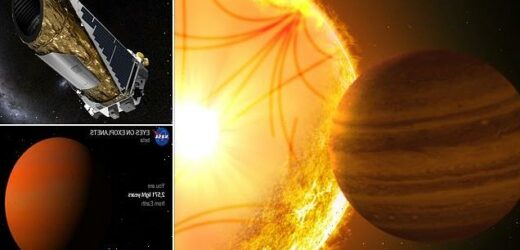Is this Earth’s ultimate fate? Alien planet is discovered spiralling closer and closer to its maturing star until collision – and experts say the same could happen to our planet
- Researchers studied data from three telescopes to learn more about the planet
- Kepler-1658b, discovered in 2019, takes 3.8 days to complete one orbit of its star
- But this duration is getting shorter leading to ‘collision and ultimate obliteration’
Astronomers have discovered more information about Kepler-1658b, the first exoplanet to be discovered by the Kepler telescope.
Discovered in 2019, the alien planet, which is slightly bigger than Jupiter, currently takes 3.8 days to complete one orbit of its star, Kepler-1658.
It’s 0.0544 astronomical units (AU), or 5 million miles, from its star – but is spiraling closer and closer, eventually leading to ‘collision and ultimate obliteration’.
‘Death-by-star’ is a fate thought to await many worlds – including Earth – billions of years from now.
An artist’s concept of the planet Kepler-1658b orbiting its star. Kepler-1658b, orbiting with a period of just 3.8 days, was the first exoplanet candidate discovered by Kepler
Name: Kepler-1658b
Type: Gas giant
Distance from star: 0.0544 astronomical units (AU)
Orbit duration: 3.8 days
Mass: 5.8 times the mass of Jupiter
Radius: 1.07 times that of Jupiter
The new study, which was based on data from three telescopes, has been led by experts Harvard-Smithsonian Center for Astrophysics in Cambridge, Massachusetts.
‘We’ve previously detected evidence for exoplanets inspiraling toward their stars, but we have never before seen such a planet around an evolved star,’ said Shreyas Vissapragada at Harvard.
‘Theory predicts that evolved stars are very effective at sapping energy from their planets’ orbits, and now we can test those theories with observations.’
As its name indicates, astronomers originally discovered the exoplanet with the Kepler space telescope, a pioneering planet-hunting mission that launched in 2009.
About 2,600 light years away, it was the very first new exoplanet candidate Kepler ever observed.
However, it took nearly a decade to confirm the planet’s existence, at which time the object entered Kepler’s catalogue officially as the 1658th entry.
Kepler-1658b is a so-called hot Jupiter, meaning it is on par with Jupiter’s mass and size but is in a scorchingly ultra-close orbit about its host star.
As a comparison, its distance from its star (5 million miles or 0.0544 AU) is about an eighth of the distance between Mercury and our sun (36 million miles or 0.4 AU).
This is an artist impression of the Kepler Space Telescope that was decommissioned by NASA in 2018 after nearly a decade of service
Detecting exoplanets and exomoons
Exoplanets are planets outside of our solar system. Likewise, exomoons are moons outside of our solar system.
Spotting a moon or even a planet hundreds to thousands of light-years from Earth is anything but straightforward.
Moons and planets can only be observed indirectly as they pass in front of their host stars, causing the star’s light to intermittently dim.
Catching one of these fleeting transit signals with a telescope is tricky, and so is interpreting the light-curve data.
Exomoons are even harder to detect than exoplanets because they’re smaller and block less light.
The researchers say Kepler-1658b’s orbital period is ever so gradually decreasing – at about 131 milliseconds (thousandths of a second) per year – so it’s getting closer and closer to its star, known as ‘orbital decay’.
Detecting the orbital decay of exoplanets is a challenge because the process is very slow and gradual, so it required multiple years of careful observation.
The watch started with the Kepler telescope, which was officially retired by NASA in October 2018 after nearly a decade of operations.
Researchers then used the Palomar Observatory’s Hale Telescope in Southern California and the Transiting Exoplanet Survey Telescope (TESS).
Scientists looked through the data for transits – periodic dips in starlight that indicate a planet is crossing and briefly blocking its star’s light.
Over the past 13 years, the interval between Kepler-1658b’s transits has slightly but steadily decreased, they found.
As for what’s causing the orbital decay, the researchers point to tides – the same phenomenon responsible for the daily rise and fall in Earth’s oceans.
Tides are generated by gravitational interactions between two orbiting bodies, such as between Earth and the moon, or between Kepler-1658b and its star.
Pictured, an illustration of the Transiting Exoplanet Survey Satellite (TESS), launched in 2018. The spacecraft is searching for planets around the closest, brightest stars
The bodies’ gravities distort each other’s shapes, and as they respond to these changes, energy is released.
These tidal interactions can result in bodies pushing each other away – the case for the Earth and our slowly outward-spiraling moon – or inward, as with Kepler-1658b toward its star.
Also, Kepler-1658b’s star has evolved to the point in its stellar life cycle where it has started to expand, just as our Sun is expected to, and has entered into what astronomers call a ‘subgiant’ phase.
Subgiants represent a class of stars that have evolved off the ‘main sequence’ and have run out of hydrogen for nuclear fusion, causing their core to collapse and their outer envelope to swell.
Subgiants eventually become red giants – voluminous dying stars in the final stages of stellar evolution, with big, puffy atmospheres that pulsate.
Vissapragada and colleagues expect the TESS telescope to uncover numerous other instances of exoplanets fatally circling their host stars.
‘Now that we have evidence of inspiraling of a planet around an evolved star, we can really start to refine our models of tidal physics,’ he said.
‘The Kepler-1658 system can serve as a celestial laboratory in this way for years to come, and with any luck, there will soon be many more of these labs.’
The findings were published in The Astrophysical Journal Letters.
If you enjoyed this article…
Aliens yet to contact Earth ‘because there’s no sign of intelligence’
Disabled astronauts complete a zero-gravity flight 25000ft above Earth
2 MILLION pounds of rock was ejected from asteroid during NASA’s DART
SORRY EARTHLINGS: OUR SUN WILL BECOME A RED GIANT IN ABOUT 5 BILLION YEARS BEFORE SHRINKING DOWN TO A COMPACT WHITE DWARF
The Sun is only 4.6 billion years through its roughly 10-billion-year lifetime.
When hydrogen fuel at the centre of a star is exhausted, nuclear reactions will start move outwards into its atmosphere and burn the hydrogen that’s in a shell surrounding the core.
As a result, the outside of the star starts to expand and cool, turning much redder.
Over time, the star will change into a red giant and grow to more than 400 times its original size.
As they expand, red giants engulf some of their close-orbiting planets. In the Sun’s case, this will mean the fiery end of all the inner planets of our Solar System, which might also include the Earth.
But don’t worry – this won’t happen for another 5,000,000,000 years.
Once swelled into a red giant, engulfing the inner planets and searing the Earth’s surface, it will then throw off its outer layers, and the exposed core of the Sun will be left as a slowly cooling white dwarf.
This stellar ember will be incredibly dense, packing a large fraction of the mass of the Sun into a roughly Earth-sized sphere.
Source: ESA/National Schools’ Observatory
Source: Read Full Article





